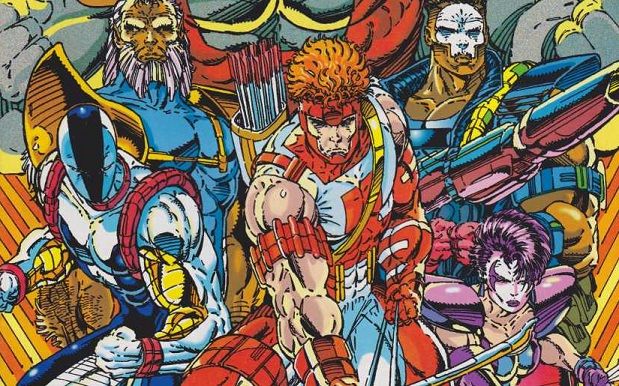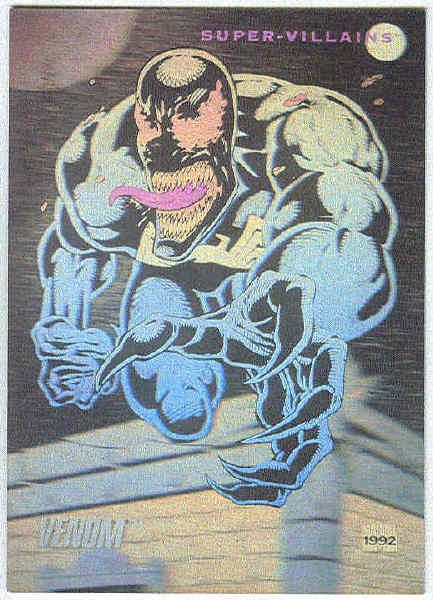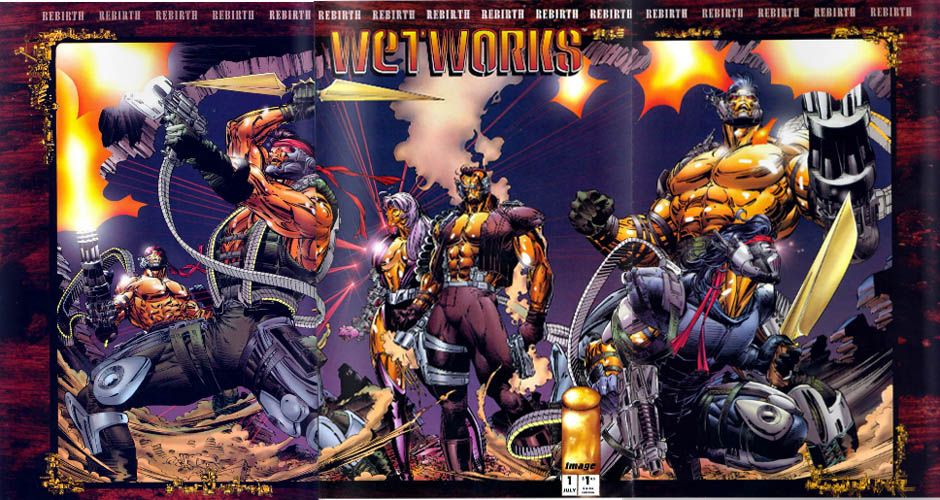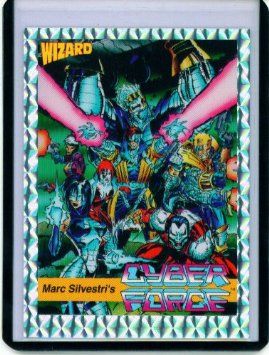Are your trading cards worth fifteen cents or a full quarter? Is your copy of Youngblood #1 properly bagged and boarded? Will Ghost Rider ever receive his own action figure? Find out in the latest edition of The Guide to the Guide to Comics.
Continuing with Wizard #14, one of the earliest issues of the magazine’s “glossy” era.
The Wizard of Cards
Trading cards were still popular with the kids in 1992, with comic and TV-themed cards selling briskly while the sports card market remained relatively strong. Stephen Shamus dedicates this installment to the concept of insert cards, which I believe later came to be known as “chase cards.” Regardless of the name, these are the special cards that were randomly inserted into packs, usually with some form of holographic or chromium gimmick. Shamus blames the failure of the G. I. Joe and Yo! MTV Raps card sets on a lack of insert cards. (I’m thinking there were other issues at play…)
The piece on insert cards is followed by a price guide for various non-sports cards. Wizard runs this card price guide for years, but I’ve always viewed it as a waste of space. Many of these cards are barely worth anything even at the height of the trading card craze, literally nickel and dime stuff, so what was the point?
Stephen Shamus, as you might've guessed, is Gareb Shamus' brother. Apparently, he was still in high school when he began this column. Tom Palmer, Jr. was also a teenager when he began writing for the magazine, from what I've read. The fact that so many of Wizard's staffers were the same age as their audience surely played a role in the magazine's popularity.
Toying Around
Wizard’s inaugural toy column, written by future DC editor Brian Cunningham. Batman Returns figures are out, and Cunningham still hasn’t seen the shortboxed Max Schreck figure. (There’s a plastic Christopher Walken out there?) Cunningham believes that the success of the Catwoman toy is a positive sign for female action figures. In X-Men news (do you get the sense that the X-Men are quite popular right now?), Cunningham has reviews of the latest wave of X-Men toys. This is when the line began to balloon, in anticipation of the new animated series.
I Love the ‘90s: “Next issue: we discuss the political status of America and its impact on social values…NOT!”
Top 10 Most Wanted Action Figures:
- Ghost Rider
- Darkhawk
- Lobo
- Thanos
- Adam Warlock/Galactus (tie)
- Nightwing/Deathstroke (tie)
- Nova, Beast (tie)
- Rogue, Hawkeye (tie)
- Psylock (sic)
- Carnage
All of these toys exist today, don’t they?
This Month’s Number Ones
Every new #1 released this month in one place for your convenience. They’ll all be worth a mint one day, surely. Batman Adventures #1, the longest-running title of this batch, debuts this month.
Money Quote: “Comic book collectors place a great deal of importance on the #1 issues. Since it’s tricky to determine whether a book will succeed, you have to choose your comics very carefully and wisely. #1 issues have been known to appreciate considerably when a series becomes very popular.”
Top 100, August 1992
A listing of Diamond’s top 100 books. The highest ordered book is Cable #1 (the initial miniseries by Fabian Nicieza and John Romita, Jr.). Other X-titles in the top ten are X-Men #13 and X-Force #15. The rest of the top ten consists of early Spawn, Youngblood, Cyberforce and WildC.A.T.S. issues. Closing out the top 100 are Archer & Armstrong #4 and Action Comics #682.
Top 10, September 1992
Doesn’t the name of this feature sound like it’s the highest selling comics of the month? It isn’t. It’s a list of the back issues that Wizard has determined to be the hottest in the country. Harbinger #1 tops the list, with Wizard touting its minuscule 40,000 copy print run. Other oddball entries are Amazing Spider-Man #101 (Morbius’ first appearance), Youngblood #1 (not yet in the quarter bins) and Uncanny X-Men #201 (Cable’s first unconfirmed appearance as a baby).
Wizard Market Watch
A summary of the market at the time. Wizard informs us that the skeptics were wrong and that back issue demand for early Image comics is strong, DC needs to get its act together, and Marvel’s holding steady with the X-titles.
Wizard’s Top Ten Hottest Artists
In future months, writers will also receive their own list. For the sake of historical preservation, here’s the list:
- Todd McFarlane
- Jim Lee
- Rob Liefeld
- Dale Keown
- Marc Silvestri
- Whilce Portacio
- Mark Bagley
- Ron Lim
- John Byrne
- Art Thibert
Wizard Price Guide
Here’s the infamous Wizard price guide. Based on prices reported by store owners and show dealers, this list is the source of much of the criticism against Wizard. Was Wizard a celebration of comics or just a tool of the speculator’s market? If you’re passionate about the hobby, what do you care if comics are “worth” anything? I will admit, however, that even as a kid with no interest in selling my comics, I was intrigued by the possibility that they were precious collectibles that someone might pay real money for someday. It’s an odd dynamic.
The question of which store owners and dealers were asked to participate has also been a source of controversy over the years. I don't think Wizard ever released their methodology for tabulating back issue prices, and it's difficult to discern just how many stores and dealers they would have to consult in order to provide a truly comprehensive price guide. Within a few years of Wizard's existence, Wizard seemed to be the preeminent source for back issue prices, with many comic shops automatically adjusting their prices to reflect the latest Wizard.
Anyway, the price guide takes up around a third of the magazine, with helpful colored bars to indicate if a comic is going up or down in value. Future issues will liven up the pages so that they’re more than just a listing of titles, but at this point, it’s a giant block of text with a few black and white cover reproductions. It’s also a list that claims Web of Spider-Man #1 is worth $17 and Youngblood #1 is selling for eight dollars. Yikes.
Magic Words
This is Wizard’s letter column. It’s fairly dry this month, but in future issues, Magic Words will move to the front of the magazine and evolve into one of Wizard’s best features. This issue, the topics range from complaints that Wizard is evolving into a hype machine to concerns over whether or not opening a polybag destroys the value of a book. (This debate rages for years within the pages of Wizard.) We also have theories regarding the identity of the X-traitor (from Uncanny X-Men #287), and the secret origin of Cable. This issue’s fan theory is that Cable is actually Nth Man, who’s chopped off his mullet and somehow made his way into the mainstream Marvel Universe.
Magic Words is also still cleaning up the mess left by staffer Doug Goldstein, who asserted months earlier that Iron Man could beat the X-Men. It’s hard to imagine today why this bothered people so much, but it’s a controversy that runs in this column for years. Goldstein, by the way, is an executive producer and head writer on Robot Chicken today. Matt Senreich, the co-creator of the show, is yet to join Wizard at this point, but his presence will be felt in upcoming issues.
Contests
Future issues of Wizard will feature a variety of comics-themed contests. This month, there’s only one contest, a chance to win every X-Men #1 cover, signed by Jim Lee. The only requirement to enter is to answer eight questions and unscramble the circled letters to reveal the Contest Code Word. Later versions of the contests are much more ridiculous, with some of them requiring readers to go on actual scavenger hunts. I see that Wizard is already hiding jokes in the legal print of the contest; it’s not much of a joke this issue, but later on, some of the hidden Wizard jokes will crack me up.
Polybag Stuff
Every Wizard issue is polybagged with some kind of giveaway. This month, it’s a prismatic Cyberforce trading card. My life wouldn’t be complete without it. Upcoming issues will be packed with giveaways; everything from mini-comics to AOL trial discs. I’m not planning on keeping track of everything you get with each issue, but just know that any random issue of Wizard featured all kinds of unsolicited extras that would decorate the floor the first time you opened the bag.
And that’s Wizard #14 in a nutshell. A lengthy, unwieldy nutshell. I assure you, future editions of this column won’t be so long. I’ll hit the highlights, point out some of the pressing topics of the day, and then move on to another issue. I don’t plan on looking at every issue of the magazine, but I’m open to suggestions regarding specific issues. If you have a favorite memory of Wizard’s past you’d like to see covered, leave a comment and I’ll see if I can include it in the review series. Until next time, you can check out Not Blog X or follow me on Twitter.




